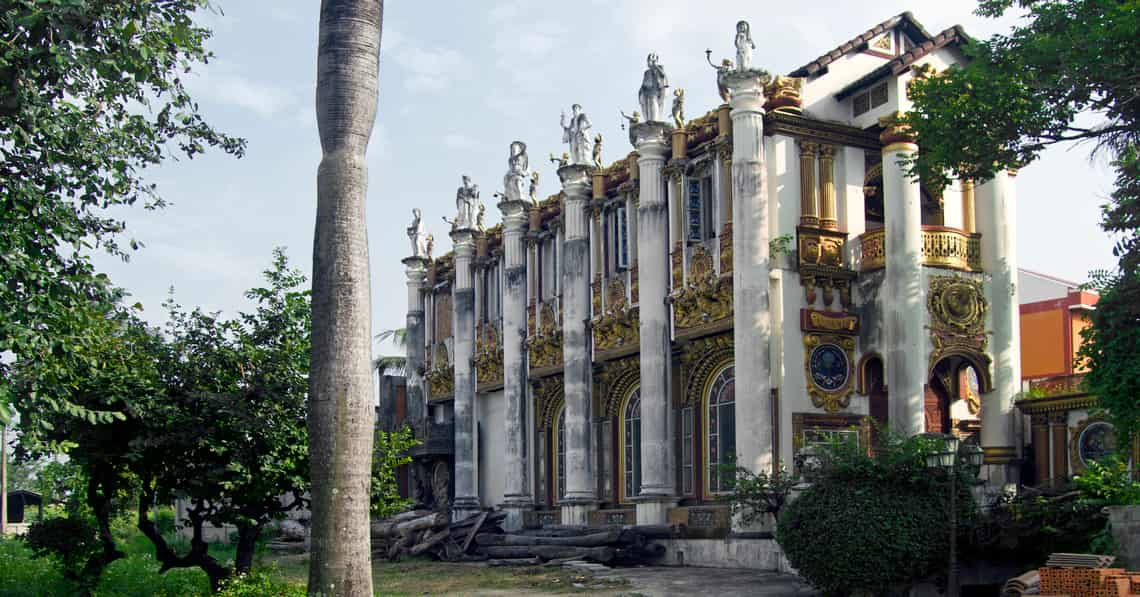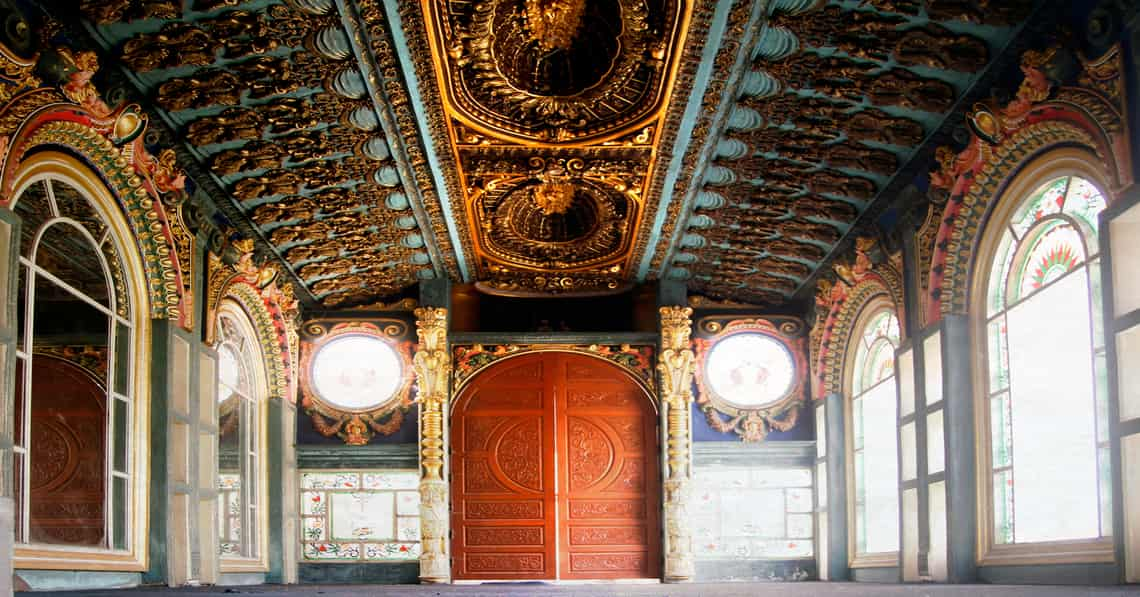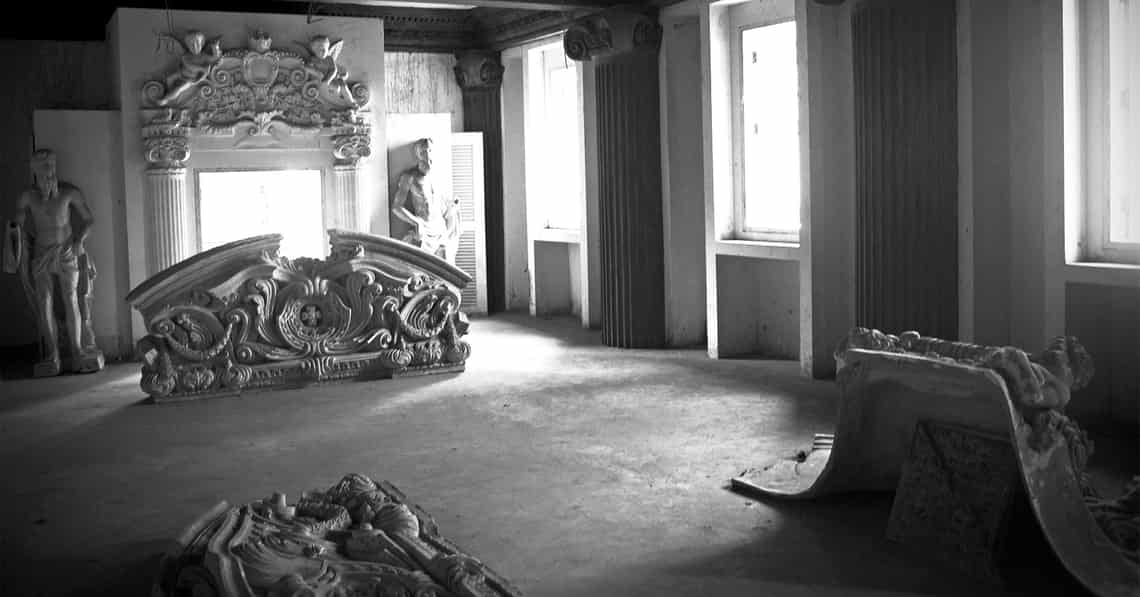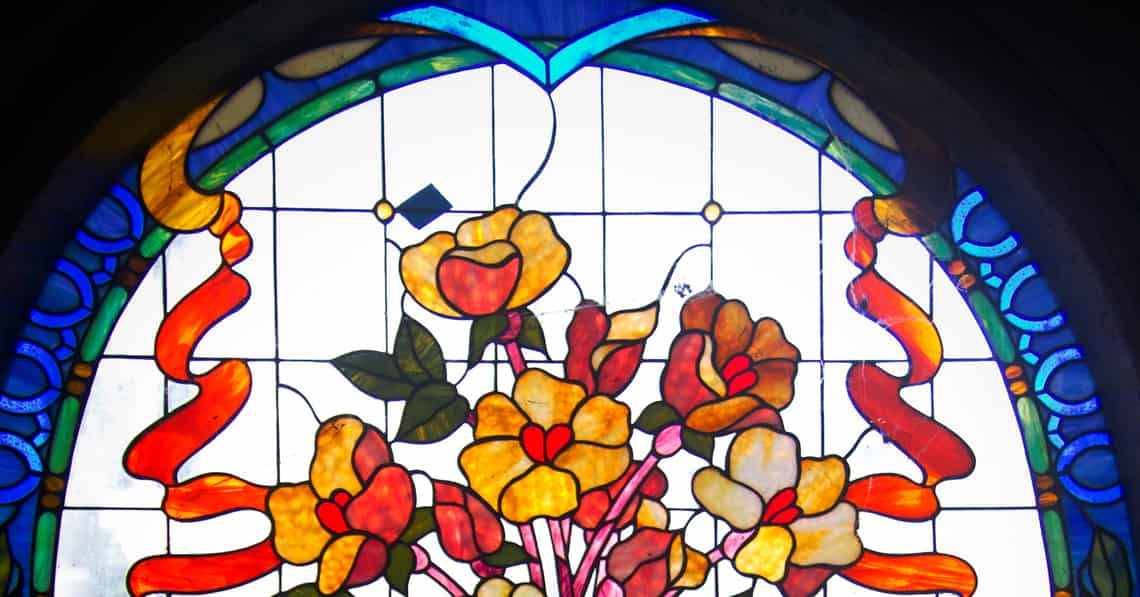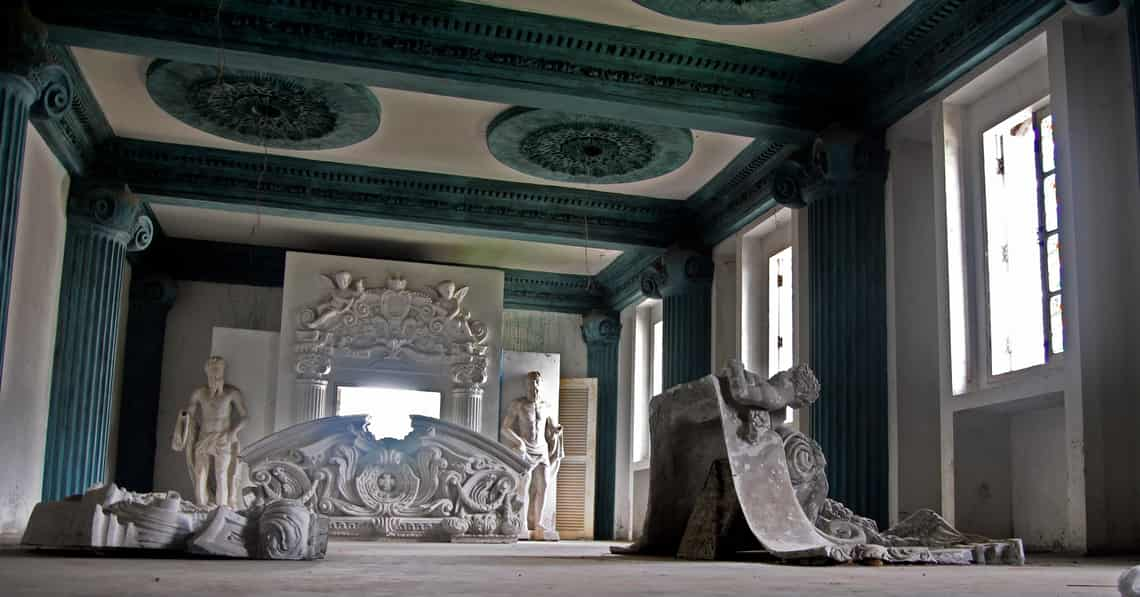(slide show photographs courtesy of Charles Taylor)
It’s that time of year again – Halloween. Ghosts, goblins, ghouls, you name it and surely there’s someone dressed up as it asking for candy door-to-door. This gimmicky tradition isn’t native to Thailand. In fact, the notion of poking fun at anything involving the supernatural doesn’t really jibe with Thai culture. So, as an avid paranormal enthusiast, I wasn’t too surprised when I found no haunted tours of the city.
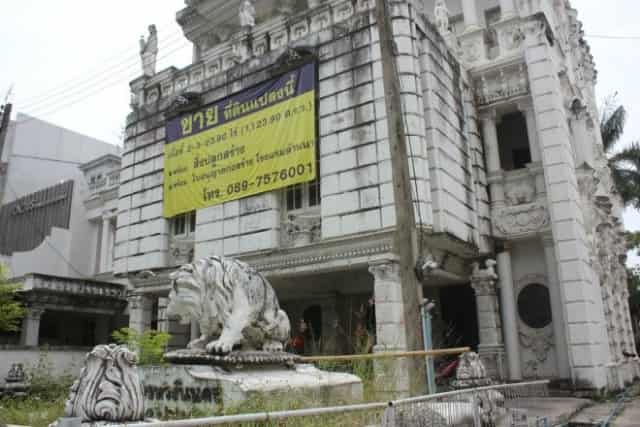
Fine, I thought. I haven’t come to Chiang Mai to hunt for ghosts. I let it slip away from my head as the weeks went on. Soon after I arrived, I wandered the old city, indulged in a few cheap massages and perused the night markets.
Then one day I came across a tale from a colleague regarding an abandoned white building in the northwest corner of the old city called Jangmuarinnakorn House, or more colloquially the White Lion House. It is said to be one of the most haunted buildings in the city.
Apparently it was doomed from the beginning, due to its location, which according to various superstitions is an unlucky place to build a home. But one man defied the negative feng shui and decided to build a home right on that cursed spot anyway. All this may sound much like the set-up for a good horror movie (“The Feng-Shui’ening?”), because not long after the move in things went awry and the man, in true Lizzie Borden fashion, hacked his entire family to pieces with an axe. Or so the story goes.
The house currently remains abandoned and empty, save for a few troubled squatters. If I can’t find any ghost tours, the best I can do is explore an abandoned haunted house, I thought. Evidence: that’s always the key for any paranormal hunter. Whether on film or video, it’ll trump an anecdotal story any day. I wanted to get some.
Superstition in Thai culture runs rampant in the face of an ignorant tourist such as myself. Upon further research, it’s improper for anyone ghost-hunting to not make the trip without a peace offering at a local temple. As a foreigner, it’s also important, apparently, to have a native Thai accompany my mini-pilgrimage. I couldn’t quite figure out an easy way to say, “Will you help me make a peace offering to a ghost so I won’t get haunted?” And all the gesticulating in the world won’t get that across. So, unable to find one, I quietly ventured to the nearest temple I could find, fell to my knees and took a bow. Hopefully that would do.
Now I needed to get there. Two taxi drivers flat-out refused to go when I showed them the name of the house in Thai. “I know, I know. No, no,” said the first. The second merely shook his head and drove away. The third one, a younger fellow with sunglasses, graciously accepted, but for double the usual price, 40 baht. I began to wonder if there really was something to these legends as we trundled towards the moat. What was I getting myself into? Did the first two taxi drivers have better sense than I?
Upon arrival, I was greeted by ominous statues of roaring white lions and two buildings, one behind the other. I decided to try the smaller one first. The entrance had more lions, as well as beautiful granite statues of what looked like Greek gods. As inauspicious as it looked, the top of the house said “House of Success.” Sort of ironic given what supposedly happened here, eh? There was no “real” security on the house save for some loose wiring keeping the front doors shut. I opened it and was greeted by a cathedral-like setting.
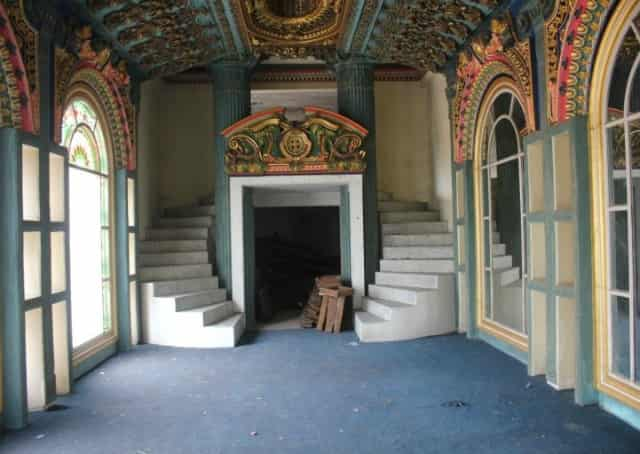
How could someone leave this abandoned? I thought. Oh right, the bloody murders and feng shui…
As I continued around what was surely the most beautiful abandoned house I’ve ever been in, I took pictures, but felt my palms begin to sweat as my uneasy feeling deepened. I had given my peace offering at the temple – nothing to worry about, right? I tried to reassure myself.
The uppermost level contained a room that was almost as exquisite as the main floor. Green columns held up the structure with two Greek statues at the end of the long hallway. A beautifully carved marble bench sat in the middle. I continued snapping photos. There was a third room near the entrance to this one, plastered over with metal sheets and locked tight. Where did it go? Why was it locked? There was not a soul in sight I could ask.
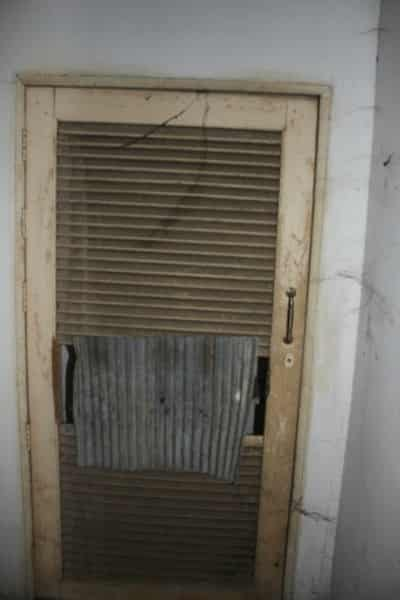
Then suddenly, I was approached by a pink-shirted Thai construction worker shouting: “No, no!” Spooked, I quickly made my exit. But my explorations weren’t finished.
The main house was much taller, with many more levels to climb. I waited five minutes before entering to make sure the pink-shirted fellow wouldn’t see me. The house was eerily quiet. I looked up the dirty stairs only to be startled by the sounds of a chicken behind me. (Not a ghost chicken, I think, but who can tell?) As I strolled up the stairs, I could see clear evidence of squatters with mattresses strewn about as well as televisions in the locked rooms. I felt chills as I walked through the house and certainly trepidation as I approached the dark, dank basement, just beckoning to be explored. However, it would take a braver man than I to explore it.
Back outside in the sunshine, I reviewed my pictures. Alas, no ghosts were captured on film. So, with no real evidence beside my own mischievous imagination and a few chills, I continued on to my next location.
Another story my colleague told me involved the spirits of the many dead that inhabit the area of Suan Prung Gate in the southwest corner of the old city. Ordered to be built by the wife of Prince Saen Muangma in 1411 AD, the gate was subsequently used to transport all the dead bodies out of the city as well as a place for executions, usually by shoving a “sharp stick into the stomach.”
For a medium, or curious paranormal investigator like myself, it might be a good place to make contact with the other world. Having already paid my respects, I was hoping I would still be in an aura of protection from any unwanted ghosts inhabiting this lowly Canadian. I opened up an audio recorder on my phone and, under my breath, politely asked the spirits to make themselves known. Having said this in English, and communicating with people who have been dead for more than 600 years, I wasn’t hopeful. Playing back my audio recording, all I heard was an ominous hiss mixed with the low rumblings of pedestrians. I would need special equipment to sort out the noises on a lower frequency.
Another false start? Perhaps. But even though I was showing a lack of evidence in my findings, I was gaining an appreciation for the rich folklore that this city contained.
Closer to home (or work, as the case may be, the Citylife office building has an interesting history. My colleagues have mentioned that two child ghosts haunt this building. The Thai people have a word for ghost children – rak yom. Was this building haunted by rak yom? According to the man who installed our air-conditioning units last year, yes, and they loved to run around on the third floor.
My interest was piqued as I listened to stories fly among the staff, positing different theories of the building’s history. Before Citylife moved in, what was it? A gambling parlour? A brothel? There are inexplicable locked vaults in the building that would fit in with these theories, and numbers on each door. I spoke to Siin Naisena, the building’s resident caretaker, to learn more.
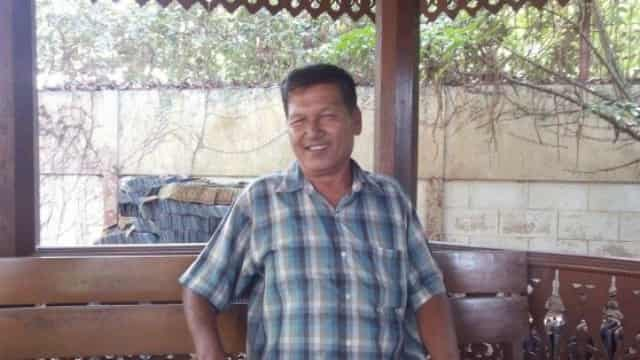
Siin told me that the building is no more than 20 years old, but when Citylife moved here the owner mysteriously refused to tell him its prior function.
“I found evidence that they used to make jewellery here,” he told me, although he seemed less than sure. I asked if he had ever seen or heard any ghosts. “I would be walking through the building at night and I would hear footsteps follow me. They wouldn’t be of bare feet but of someone wearing shoes,” he said.
The weird thing is that at Citylife, all employees must remove their shoes before coming in. “When I would stop, the footsteps would stop. I felt like I was being followed. I hear running sometimes too,” he continued, looking uncomfortable.
As I concluded the interview, I noticed the shrine-like structure at the front of the building. I asked my colleague Faa about this and she told me it was a spirit house, used to appease unwanted spirits so they won’t enter the building. These spirits, if left unchecked, would bring bad luck to a building.
It seemed that Chiang Mai was more of a hotbed for ghosts than I thought. But why no ghost tours? Why no monetisation of such a scintillating degree of paranormal activity? For a more academic take, I contacted Andrew Alan Johnson, an assistant professor of anthropology at Yale-NUS College in Singapore who authored a book called Ghosts of the New City: Spirits, Urbanism and the Ruins of Progress in Chiang Mai.
“Here, asking about paranormal tours imagines a certain distance from spirit beliefs,” he told me. “Sigmund Freud’s idea of the uncanny worked only when a person believed himself to be beyond a certain belief (and then to have it suddenly reappear). But with an active spirit world embedded within everyday Buddhist practice, with a real belief that spirits can cause illness or misfortune, why on earth would one seek out ghosts by going on a tour? Evangelical Christians in my own hometown in the United States, people who genuinely believe in the existence of the devil (and that Satan is behind hard rock music), don’t go to death metal concerts for fun and titillation. One needs to be sceptically distant from a belief in order to experience it as fun.”
This made perfect sense. Back home, our belief in the supernatural is largely trivialised. Most of us don’t think we’ll actually get cursed by a ghost, or possessed attempting to find one (certain mediums will supposedly cast protection spells, but they are in the minority). We certainly wouldn’t go to a temple to appease it before searching for one.
Meanwhile, the Thais take their spirits very seriously. “From a young age, we were raised to believe ghosts were real and to have respect for them,” explained Yong, another Citylife employee who claims to have a special connection with the paranormal world. “Some people, when a house is haunted, will adopt the ghost of their house and keep them as a sort of ‘pet’ for good luck. For example, if the spirit died from a car crash and we treat the ghost well, we will find better parking spaces.”
There’s a specific type of ghost for people killed in car crashes? What other spectral entities existed in our realm? I wondered.
“The Thai believe in over three dozen different types of ghosts,” Johnson clarified. “There’s ghosts with the skeletal heads of horses, ghosts that fly about at night riding a mortar, tiny ghosts that eat livers, and ghosts of all different kinds of trees.”
Why are we in the west then left with such a small smattering of bump-in-the-night sorts of ghosts?
“Maybe the problem here is in translation,” replied Johnson. “If we translate the Thai word phi as ghost, it only conjures up one small bit of what that word actually means. Rather, the use of phi in different contexts mixes what we might call ‘ghost’ with ‘spirit, fairy, witch, god, monster, angel, demon, elf, dryad’ among many, many others.”
But with the influx of Thai horror films, such as the 2011 hit Ladda Land (which tells the story of a family that moves into a haunted subdivision), would the rich culture of Thailand’s supernatural lore get watered down by the influences of bigger budget Western style horror movies? Johnson says no.
“New forms of belief pop up to replace those that die away, and since these new forms of belief often draw upon ‘accepted’ or orthodox forms of belief, they might look less strange or interesting to us. But in their logic, they are no less magical.”
I would like to think that even if Western influences take over the rich ghostly culture of Thailand, new ones will emerge, as Johnson suggested. The intrigue in ghosts seems to be ubiquitous across the globe, with most cultures sharing some sort of lore for them. Thai people’s superstitious beliefs are deeply rooted in animism, meaning that a spirit can inhabit anything, from a rock, statue, animal, person, etc.
This is one of the reasons why there are ghosts for so many things. Some Thais might also turn to a spirit to solve problems involving anything from love to money to health.
“We see more ghosts, spirits, fairies, genies, etc. in religious systems that incorporated (instead of wiping out) animist systems of belief,” said Johnson. “That’s why places with very animist-influenced religious beliefs – Thailand or Japan, for instance – have such wonderful spirit worlds.”
So there you have it, readers. Having come here as an ignorant tourist hoping to find a paranormal scene, I have found instead something better: a culture that has an innate respect for the dead and treats them accordingly. No tacky haunted tours and no exploitation of any kind of haunting. The more I research animist traditions, the more I respect their diversity and reverence for all things spiritual. But I’m still not staying in this building late at night…
Happy Halloween!
